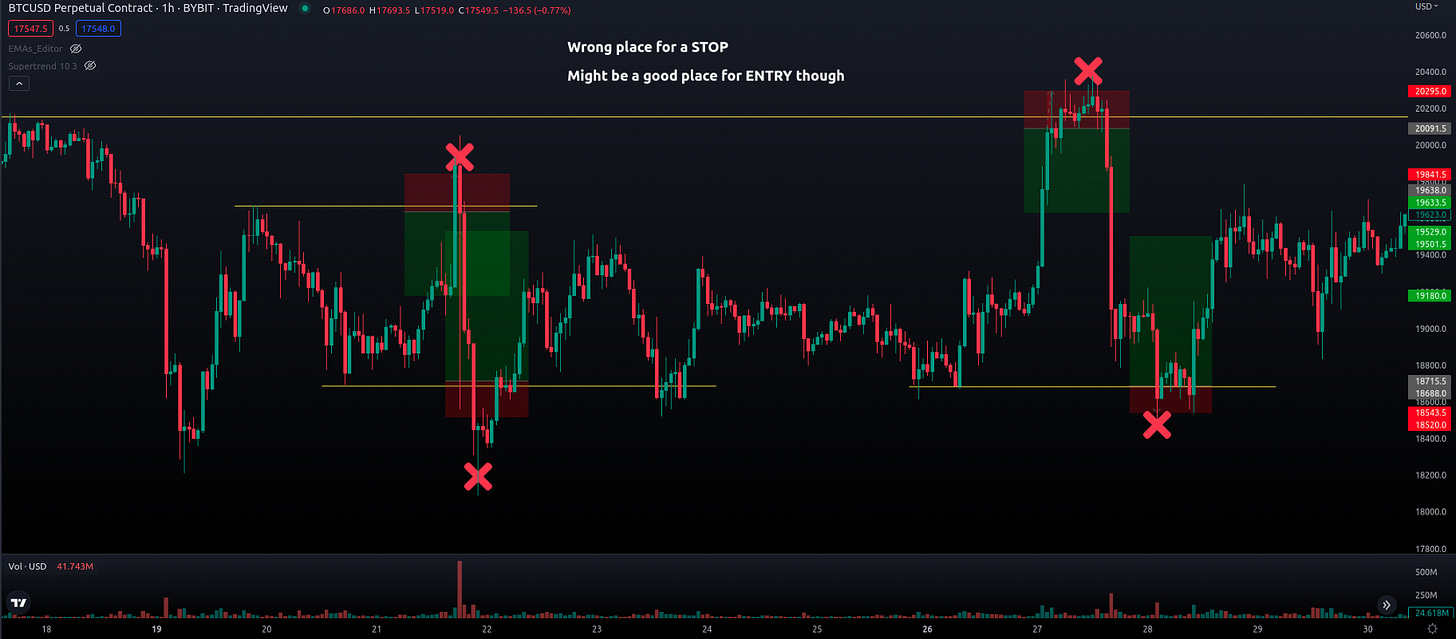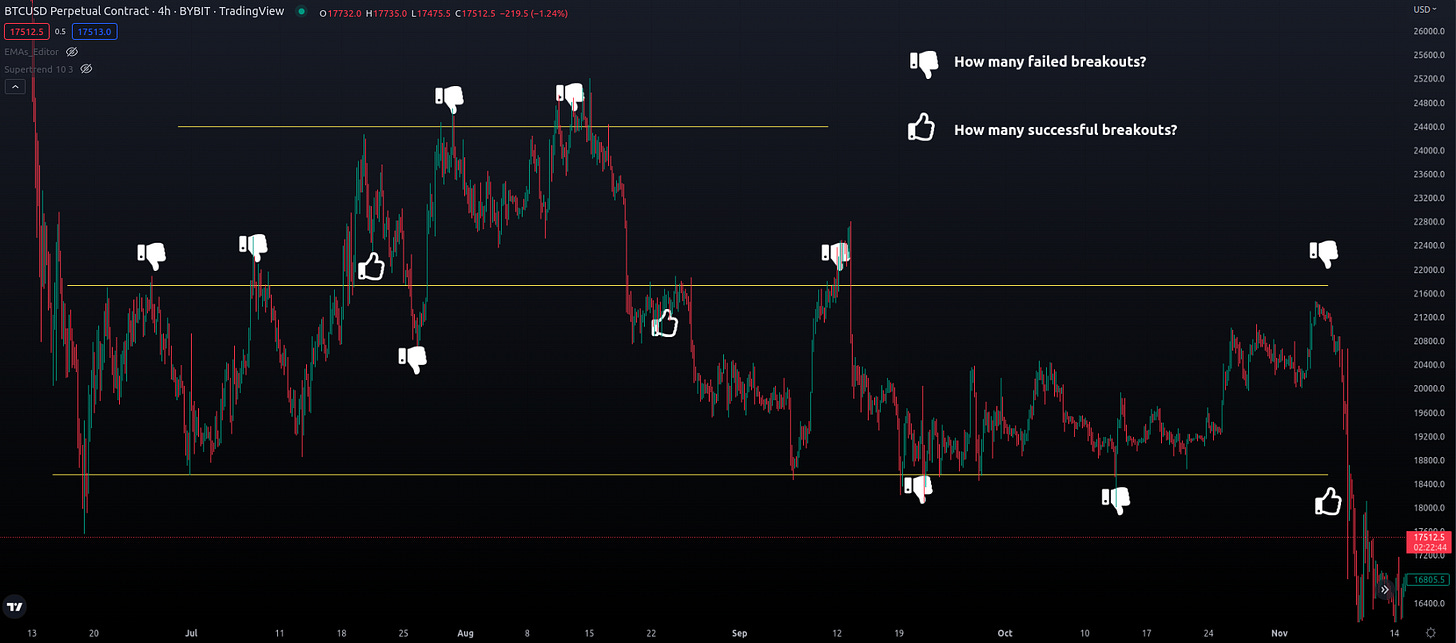The market is not your friend. It is not your enemy either. The market is just a chaotic, random mess composed of millions of traders, investors, speculators, amateurs, professionals and robots, all trying to beat each other and extract profit from the market. Sometimes the market gives and sometimes it takes away. It is not a benevolent entity, nor is it malevolent. The market simply doesn’t care.
If the market is the vast ocean, we’re the fish that are just trying to survive and thrive in its waters. Within its dept all the living creatures play their little games. From the large predators at the top of the food chain, to the plants at the bottom and everything in between. None evil, nor good. Their struggles, their pain or joys, mean nothing to the ocean. On the surface the ocean is wild and chaotic, but deep down it is tranquil and silent.
The market may not care and may not actively try to take your money, but market participants might. Such as large whales playing games, herding smaller “game” into kill zones, until they've had their fill. But even these large, professional actors aren’t your enemy. No. You are. We are all our own worst enemy in trading, whether we want to face up to that or not. Our success in trading will be determined by our discipline, emotional control, trading strategies and risk management. The market doesn’t care and nor does your opposition, so stop playing the role of the victim.
But I’ll give you this, it sometimes sure does look like “they’re” after your stops. It feels like you’re being purposefully tricked into wrong moves, by way of false signals and traps. One could easily surmise that he is being consistently led astray with all the fakeouts in the charts.
It’s not hard to feel personally attacked when trading, as idiotic as that may be. You can actually feel as if the market is making a fool of you, actively, deliberately exploiting your weaknesses, hunting your stops, hiding its true will. It may look and feel that way, but a rational actor will realize it’s just an illusion.
Market participants do play their little games though. Let’s look at some of those games, so that we may be better prepared for battle next time we step into the battlefield.
We will not be wasting time guessing the reasons or malicious intentions of exchanges or large players in the market, because we can’t really prove it and it doesn’t change anything. These patterns exist and you will be seeing them in your day to day trading all the time. You might as well learn to spot them and incorporate them into your trading strategies.
Liquidity pools, stop hunts, fakeouts
Price will often cross support or resistance lines for a short time and then wick back inside, reversing its course and continuing in the direction it came from. A fakeout, a reversal of sorts. Meaning that this particular support or resistance actually worked, but only after having stopped out all the traders. These patterns (price action) can be found on practically any chart or time frame.
The game the trickster is playing on you here is the illusion of a level actually losing ground, support or resistance failing to do “their job” and there being a breakout happening at this moment. It’s a lie! A trick in most cases.
In fact, fakeouts are disproportionately more prevalent in the charts than actual breakouts! Remember this fact.
In ranging environments this is self-evident, but in trending markets things do get a bit more complicated. The odds then favor the continuation of a trend, so it would be smart for us to play predominantly the winning side or at least exercise additional caution when counter trend trading. In bull markets we should focus on looking for long opportunities and in bear markets short opportunities.
Above resistance and below support are the so-called liquidity pools.
Perhaps not any and all, but the more important ones. The expectation is that this is where a lot of traders want to do business, so their orders are rather crowded and ripe for the taking. They provide liquidity where a large entity can hide and fill up its orders.
Near support levels you will find
buy orders of the buyers,
the stops (stop loss orders) of those buyers and
sell orders from the breakdown traders ready to pounce on the break of support.
Around resistance the story is similar, there you would expect to see
sell orders from the sellers,
their stops slightly above resistance and
bullish breakout buy orders aiming at riding the breakout move.
Then there’s the possibility of squeezing traders out of their position, the further away from the levels we go and so on.
In short, games are being played at these levels and orders are being placed in magnitude, hence more liquidity. The bigger the level, the more this is valid.
So how do we take advantage of this information?
Well, for starters you could protect yourself by not placing your stops into these zones, where they’re likely to get swooped up needlessly. Either pull them further away, or bring them in tighter and be ready to open another trade if you get stopped. Just don’t be cannon fodder for stop hunters. If you’re throwing money away, you might as well send some to me, I’ll make better use of it (options below).
Secondly, you are now wise enough to not fall for every fakeout, mistakenly thinking it’s a breakout and betting on the wrong trade. At the very minimum you should redefine and stricken your breakout trading conditions (rules, strategy), in order to avoid getting chopped up to pieces. The odds simply favor a fakeout over a breakout.
Since you now have this information and are on the lookout, why not play the game with the whales. Anticipate for these levels to get breached and then enter the trade with the big guys.
You can either do this
in the liquidity pool itself (LP), where you take on more risk of failure, or
you can wait until the price is back within range (OUO - over under over), and then join the party.
Either way, you’re now seeing the market for what it is and not falling for the “faints”. Good work!
Do yourself a favor and go through your favorite charts. See if you can spot these patterns and how often they repeat themselves. Pay special attention to the price action at the levels and what the volume is indicating. Here’s a few examples for you.
In part two of this two part post on the great trickster, we’ll be looking at some other games that are being played in the markets, with the intention of deceiving you. Subscribe and get the next post right in your mailbox, as soon as it is published.
Continue to part II Market - The Great Trickster, Part 2/2.
Sharing is caring, especially in the online digital world.















